Thailand was never a European colony, so even though the city is very Western on the surface, deep down it’s very Asian. It’s quite enigmatic, and I like that. I can’t get to the bottom of Bangkok, and I never will.
Lawrence Osborne
12th November, 2023: Before the trip, Mum requested a day in Bangkok dedicated solely to shopping and markets. She wanted to do it on November 14th, one day before leaving the city. But I informed her that because the markets are so busy on weekends, we may possibly use this day to visit the markets. So, my plan was this:
- Nonthaburi Market
- Tao Poon and Chatuchak Weekend Market
- MBK Centre and Siam Square.
And we begin our day at 08:30 with a stroll to the Sathorn Pier (from the apartment, it’s a short walk to Charoen Krung Road before getting the number 1 bus to the “Robinson Bangrak BTS bus-stop”). The weather was sunny and comfortable. We reserved two tickets to the Nonthaburi Pier (N30) and presented them to the woman at the ticket-checking booth. She informed us that a MINE Smart Ferry (a recently released battery-operated ferry) docks in Nonthaburi and directed us to board it.
The seating arrangement (the one we traveled on had a capacity of 150 seats) and decor appeared to be high-end. After five minutes, the ferry left. This was our first ferry voyage across the Chao Phraya, and the scenery outside looked spectacular. Aside from its scenic beauty, the river was home to a variety of ferries (Chao Phraya Tourist ferries, private ferries, cargo ferries, and dredgers). We were able to see several areas of interest, such Wat Arun, ICONSIAM, the Parliament, and so on. Because of its vast size, the ferry struggled to dock at Si Phraya (N2). And after some maneuvering (which took about two minutes), it was able to dock here. The passengers were all Thai; there were no other nationalities aboard the ferry save us.










It took about an hour to go to Nonthaburi Pier (yes, at 10:30 a.m.). The Clock Tower was just ahead of the station, and beyond it were this market’s merchants. Walking down Pracharat Road exposed us to the different scents, scenes, and beauty of Nonthaburi Market. Like numerous markets in Bangkok, you may buy bread things (we bought a couple at the Non bread in Nonthaburi; and it was crowded!) for only 15 baht, or a new case for your mobile phone for 10 baht. The street is dotted with old buildings, with the occasional Buddhist temple (wat). The stalls give shade as we stroll along the footpath, shielding us from the blazing sun’s beams.
We entered a road where groceries, fruits, and vegetables were sold at low costs. We returned to the main road through another alleyway. We spent an hour exploring this little but colorful market that few people frequent.
Another reason we considered visiting Nonthaburi Market was to find some inexpensive currency exchangers, as we were running low on baht. On a Sunday, both the Krungthai Bank and the Islamic Bank were closed. A search on Google Maps leads me to a SuperRich currency converter near the Sirat Expressway. We boarded the No. 63 bus to the designated location (Phong Phet), which took approximately 20 minutes. After around 500 metres, we arrived in front of a building on Ngamwongwan Road, where Google Maps reportedly placed SuperRich on the fifth level. Mum suggested if we couldn’t find it, we could go to central Bangkok to find money converters.
There was a staircase leading to the building’s second floor. When we arrived, we were startled to see that the complex was nearly vacant. There was an elevator that connected to the upper stories.









Nonthaburi Market, Bangkok.
As I utilized it to get to the fifth floor, I was even more surprised to discover where I landed. I was in a ward at Diamond Nursing Care Centre. The SuperRich couldn’t possibly be here, so I returned to the second level and asked the lady in the bakery store to direct us to it. So she brought me outdoors and instructed me to go straight. We weren’t convinced, so we went into the Makro Food Service and requested one of the personnel to assist me. She brought me outdoors and instructed me to continue walking straight ahead!
Okay, let us walk straight. After crossing the Prapa River, we asked a vagabond where the mall was. He told me something that I didn’t understand. It sounded like “Th Ma, Tha Maa!” to me. He led us to The Mall, where the SuperRich is located. The Mall is one of the shopping malls in the Nonthaburi area, and we had no plans to visit. But, in the midst of our search (which took an hour), we decided to explore it. Thank you, Google Maps, for sending us in the incorrect route.
The Mall in Nonthaburi is rarely visited by tourists, with the exception of the Thai inhabitants, who come in droves. It’s a mall, and the organization and upkeep were excellent. We walked to the fifth floor and exchanged our dollars at the SuperRich (a little station in the mall’s “government section” next to the food court). We ate lunch at Gourmet Eats (it was already 13:30) and explored the mall, including the grocery (Gourmet Market) and the electronics sector, until it was time to hit the brakes and continue on to the other markets.
One thing I appreciated about Thailand’s malls was that they cater to all segments of the population. It’s not just the Porsche and Dior, but also the street food. If consumers don’t want to buy Gucci shirts, they can buy imitation ones (albeit this is unethical). At the very least, they purchase something, if not nothing. Sushi-ro, a well-known Japanese restaurant, was one of the few restaurants in the Mall where customers could eat their food while it was being delivered to them on a circular, slow-moving rolling platform. As I ate my lunch, I looked at the restaurant’s Japanese-language advertisements. And I was aware that, despite the fact that the bulk of visitors are Thais, there is a tourist vibe (similar to what I experienced at ICONSIAM’s Unagi Toku Restaurant).








The Mall, Nonthaburi.
It’s time to head to the Tao Poon market. We took the number 114 bus from the bus stop at The Mall to the Ministry of Public Health MRT Station, which is on the Purple Line. It takes twenty minutes to get here and then to the Tao Poon MRT Station (the southern terminus of the Purple Line).






I entered the Tao Poon Market at 14:30. The merchants were still setting up their makeshift businesses here, and aside from the normal stores selling clothes, veggies, and street food, it wasn’t a large one. There isn’t much here, so we returned to the MRT station and headed to the Kamphaeng Phet station, from which you can access the famous Chatuchak Weekend Market or the Or Tor Kor Market. We wanted to investigate the former. (The Or Tor Kor Market is an agricultural market, sometimes known as a wet market.).



Tao Poon Market, Bangkok.
Chatuchak Weekend Market is Thailand’s largest open-air market, with around 15,000 vendors separated into multiple parts. Tourists may become disoriented while browsing this market because of its size. The more organized Jatujak Plaza is located near this market. The market sells a variety of things; therefore, for additional information, see this schematic map of Chatuchak Weekend Market. In the heart of the market stands an imposing clock tower.
It took nearly three hours to examine this massive market. The necessary signage indicates that you are at the market/plaza. The JJ Mall is adjacent to the Jatujak Plaza, however we did not go inside. Some stores here exclusively sell things at their MRP, while others are willing to bargain. For example, in the market, a T-shirt costs at least 200 baht, while a baseball cap costs as least 100.
As we walked, we noticed a couple of shirtless Westerners roaming around the market. At another corner, we noticed three students singing an English song. For Thais and tourists alike, the market is a melting pot of numerous merchants, fused with its intricate fragrance and views, along with tourists haggling at various stores, giving it a distinct character. From small products like souvenirs and postcards to huge items like antiques and furniture, you don’t need to go any further than the weekend market. about course, be mindful about pickpocketing. I noticed a couple of live animals (including reptiles) on sale at some of the stores in Jatujak Plaza. If you don’t want to buy anything here, you may always eat Thai street cuisine or drink a beer.
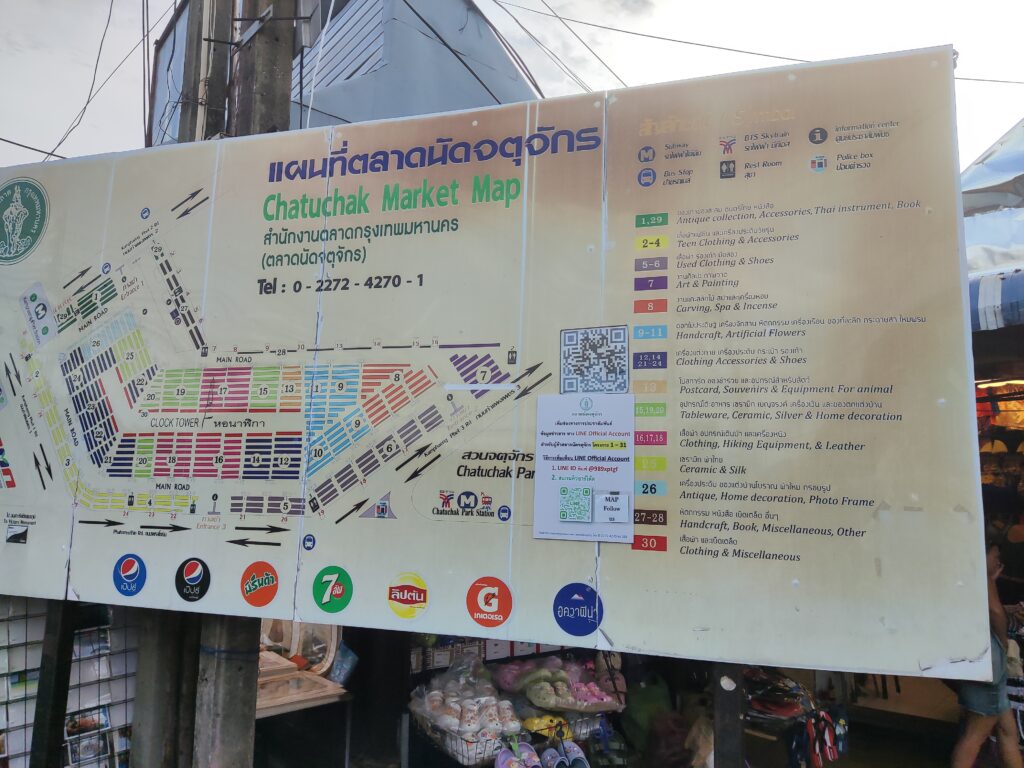

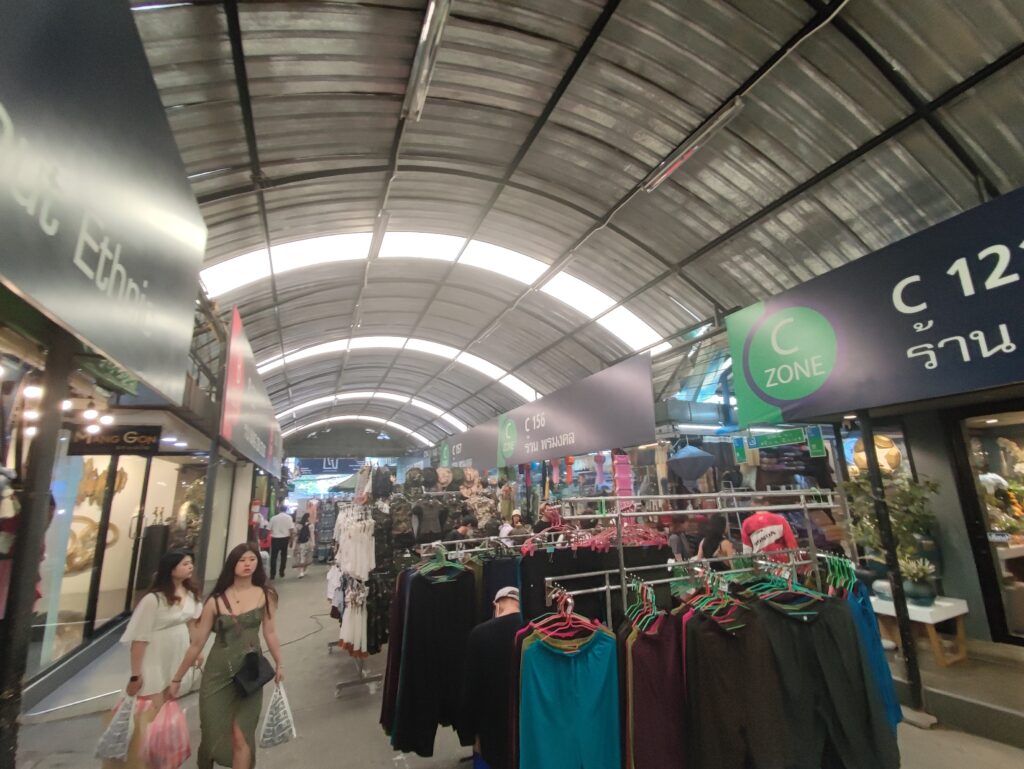

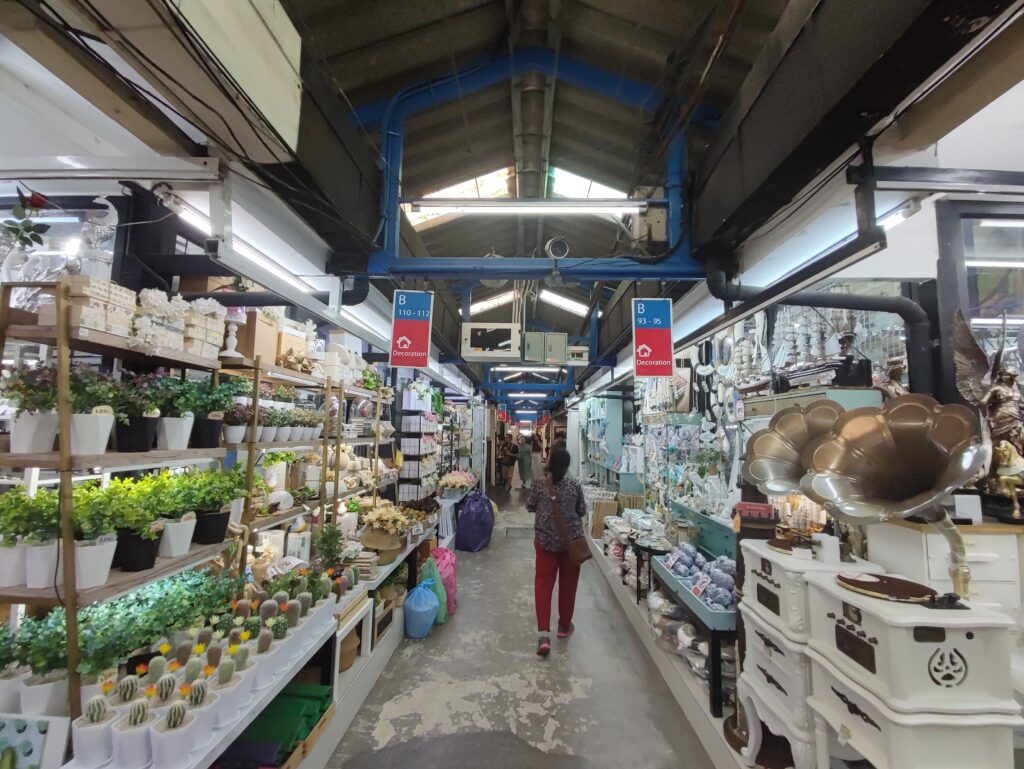
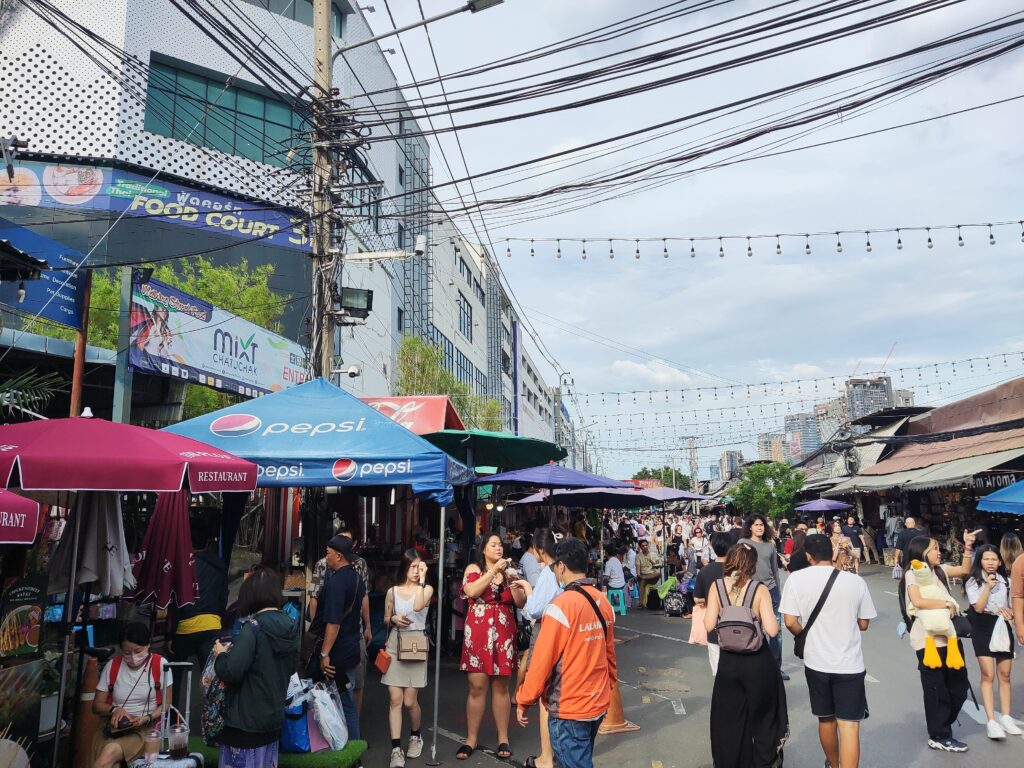
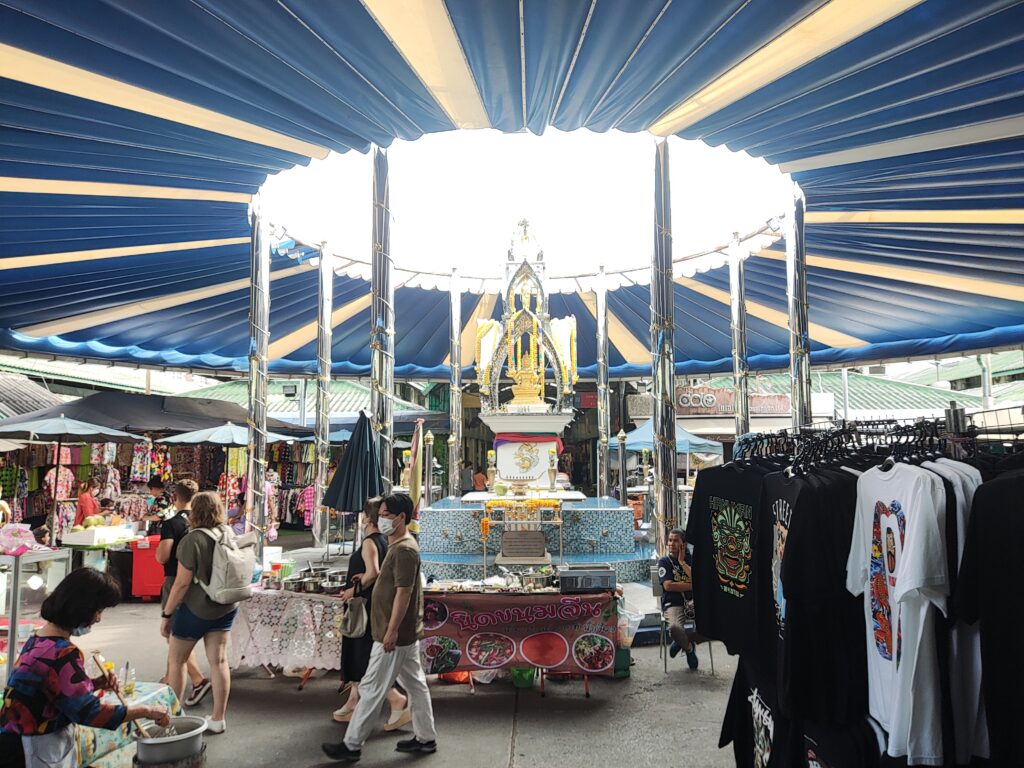
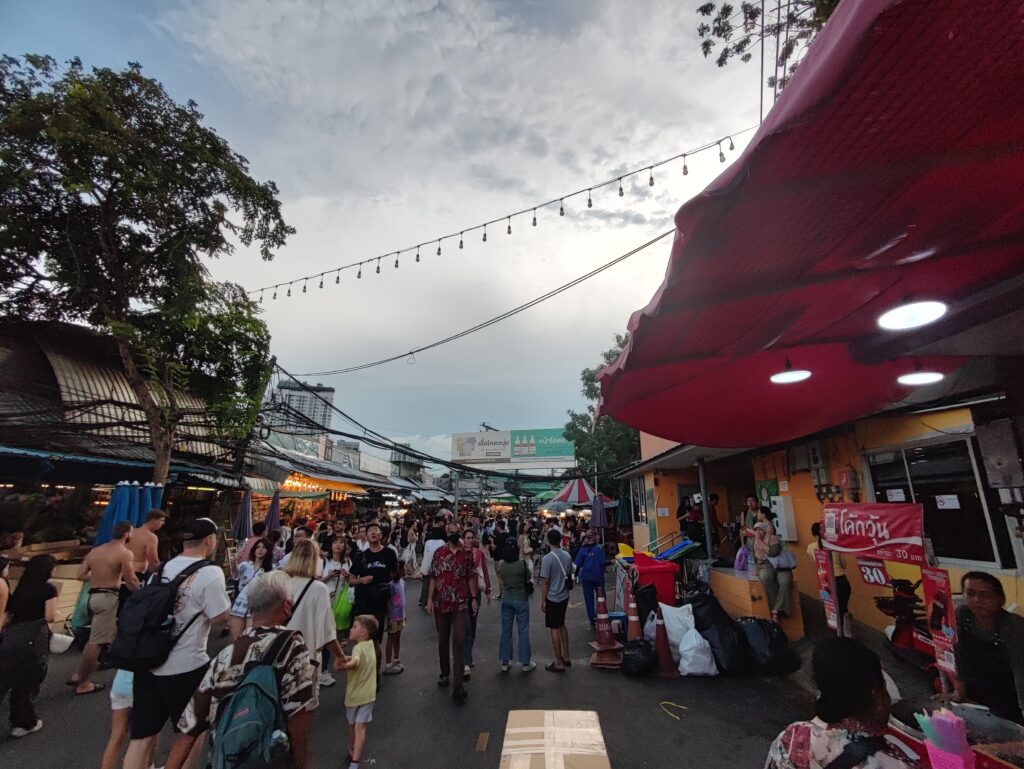

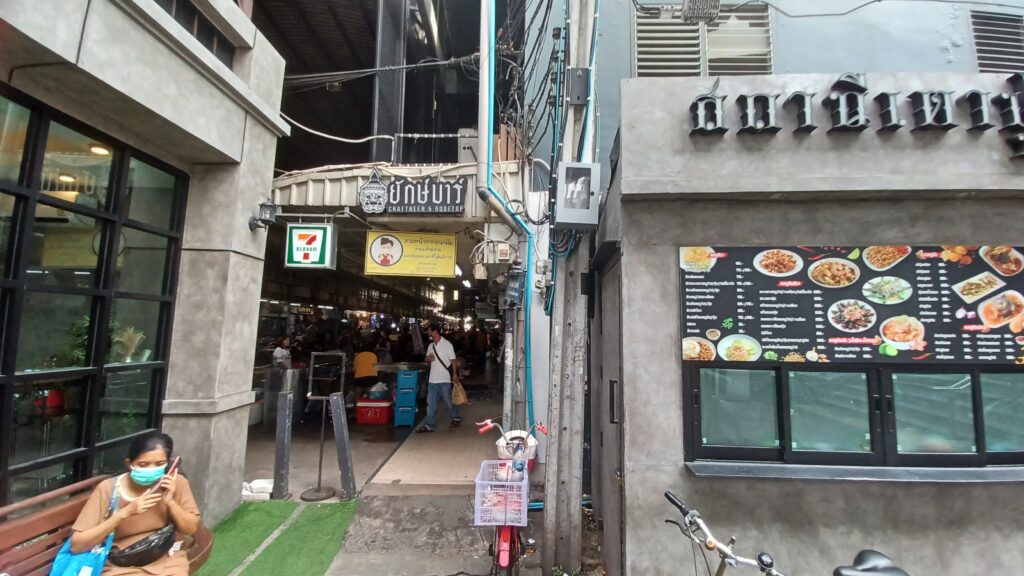
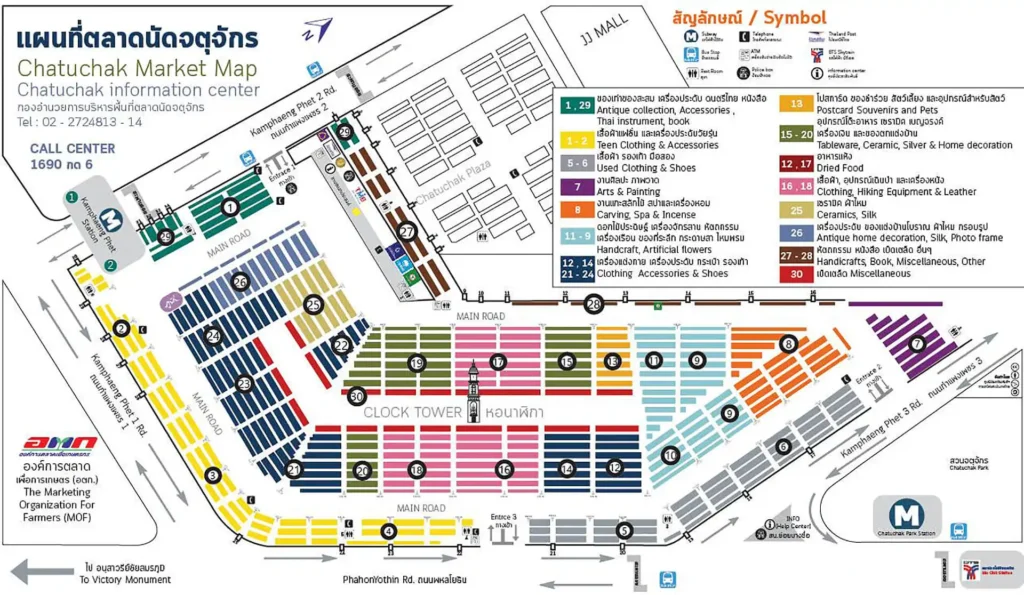
Chatuchak Weekend Market, Bangkok
And at the end of our investigation of Chatuchak Weekend Market (where we bought a few clothes), we had a rest at Bellinee’s while sipping on a Mocha. I recommend that tourists traveling here for a shopping spree visit Chatuchak Weekend Market or the MBK Center. And I believe you will like your visit in one of the following areas. Mum was exhausted, and we had another mammoth to investigate that day. We then travel to the Siam station by taking the Chatuchak Park (MRT)/Mo Chit (Sukhumvit Line, BTS) interchange. It was 18:30 already!









We arrived at the busy Siam Square. Aside from students performing live shows featuring Western music (performed by students singing and playing musical instruments in front of many students and fans), large billboards depicting stores and advertisements transform the area into an illuminated Western-style walking square even at night. And this is where the majority of Bangkok’s youth gather to have fun. Mum and I went around Siam Square, checking out some of the top stores before heading to the MBK Centre.
The acronym MBK stands for Mah and Boonkrong, the parents of Sirichai Bulakul, the mall’s developer. Their statues can be found on the ground floor. It has eight stories and is projected to house over 2,000 stores. Again, each level is divided into four pieces denoted by the alphabets A-D (aligned north-south). For those wanting to explore this mall in detail, click on the link here, which redirects to a document showing its floor plan.
How much I try to write about markets, such as this huge market (MBK), you can only understand if you go there. But I’ll try. There are MBK booklets that show the floor plan and the stores it contains. It’s a store for everyone! From Nike-looking sneakers and Gucci-looking clothes to the actual ones, it provides solutions that cater to even the poorest members of society. Restaurants and fast food establishments may be found on every floor (affordable meals are available at Food Legends By MBK on the sixth floor, which serves major world cuisines), while specific sectors, such as jewelers, fashion, and beauty salons, are located on the lower floors. The fourth floor is dedicated to technology, and you’ll be surprised to see how many stores specialize in phone repairs! The seventh floor is dedicated to entertainment and film (SF film).
There are stores that specialize in tailoring (saying it would be completed in 4 hours, but this is the tip of the iceberg — tailoring scam; you will receive poorly constructed suits). When compared to other malls in Bangkok, this is the one with the most visitors. In addition, there are some restaurants that adjoin the verandah, overlooking the cityscape and the rush and bustle of Bangkok. Just before the SIAM BTS Metro Station entrance, there is a wide space with plastic flat-looking parasols that has become known as the “selfie space”. Don’t forget to visit the MBK Centre if you have any shopping ideas.
The mall also has “Learning Hubs” where students can design and sell things (as shown in the top-center image of the collage below). Clearly, you will be treated to a variety of sounds and smells, as well as pleasant views, that will make you want to return to the mall.

















MBK Centre, Bangkok
We ate dinner at a Vietnamese restaurant at the MBK Mall for 200 baht before heading to the next mall (Siam Discovery Mall), which is connected by a walkway. The Siam Discovery Mall has a far lower population density than the MBK Centre. This mall houses all of the branded and pricey things, which are organized on each floor as “labs”. For example, the ground floor is the “Her” lab, which represents female fashion products, while the fourth floor is the “Play” lab, which has a Madame Tussauds Bangkok! For more details about its floor plan, click on the link to its official website. It took around an hour to explore the mall. If you plan on shopping here, get the “Tourist Card,” which entitles you access discounts and VAT refunds after you return to the airport.



It was 22:30 p.m., and we were fatigued. We planned to visit the SIAM Paragon and SIAM Centre malls in the evening the next day.









Siam Discovery Mall, Bangkok
So we returned to the BTS Siam Metro Station and took the BTS Saphan Taksin Metro to go home. We took the number 1 bus from Sanam Luang and were dropped off near our home (Wat Sutthiwararam). We went to bed fatigued.
13th November, 2023: For this day, we were looking into the following (which I came up with after reading Lonely Planet Bangkok).
- The Grand Palace and the Royal Theatre
- Chinatown
- The Platinum Fashion Mall (suggested by Mum, after reading some articles about it, not my idea)
We left our flat at 09:00 a.m. (I’m not going to go into detail about my pre-trip activities, including breakfast, because you, readers, already know about them, which isn’t very fascinating), and took the Number 1 local bus to Sathorn Pier. (It let us off near the BTS Saphan Taksin metro station, from which we had to walk around 500 metres to the Sathorn Pier). After obtaining tickets for the Chao Phraya Express Boat to N9 Pier (Tha Chang), we embarked on our journey to the Grand Palace by boat.








A short walk (about 750 metres) to the entrance of the Grand Palace. If you can see the Royal Thai Navy Club, you’re on the right track. The admittance charge is 500 baht per person (free for Thais). This is also Mum’s first visit to this temple complex (she had previously waited for me outside; this time she planned to do the same). I told the person at the ticket counter “nueng” and handed him a 2,000 baht note. The police officer stationed at the ticket counter whispered something into his ears. He handed me two tickets, one for me and one for Mum. So she was able to enter as well.
Before entering Wat Phra Kaew (The Temple of the Emerald Buddha), grab this guide brochure (available in English, French, German, Korean, and Chinese). It looks like the image below. It contains all of the necessary information as well as a site layout to help you navigate. You can also rent an audio guide here for 200 baht. Tour guides can be hired at the ticket booth. After taking a few shots of Mum and myself, we headed to the first location, Wat Phra Kaew.





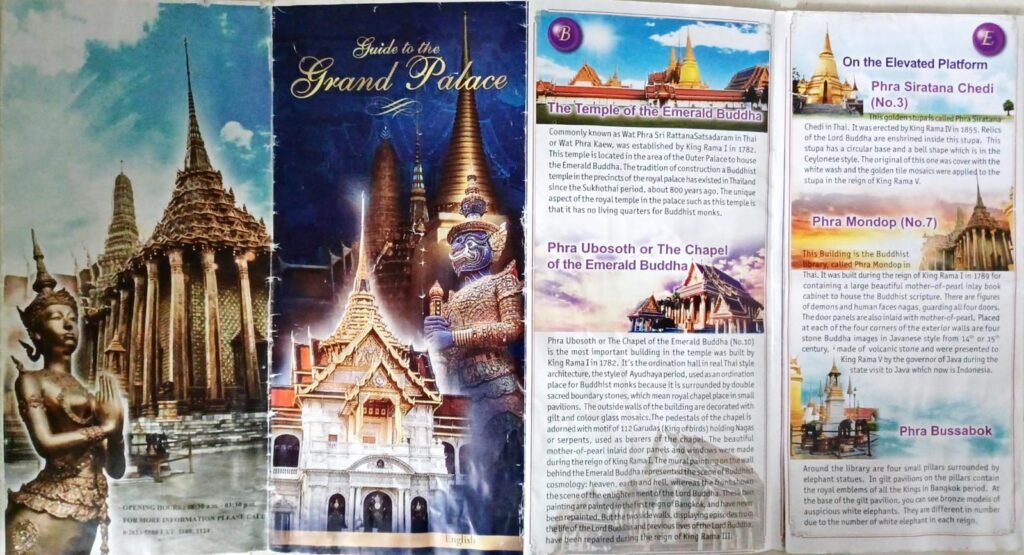
Wat Phra Kaew (The Temple of Emerald Buddha): Established in 1782 by King Rama I, it is housed in the Outer Palace and houses the Emerald Buddha. (Other areas, such as the Inner Palace and the Royal Household Offices, are off-limits to tourists, thus you will be touring the Outer Palace). This temple, unlike other Thai temples, does not have a “sangkhawat” for the monks. (referring to the living quarters, as it is recognized as a royal palace. Monks cannot remain in such regions in Thailand).
Walk clockwise through the hallway surrounding the temple (starting with the first painting) to observe Ramakien’s murals. It’s a Thai adaptation of the Hindu Ramayana epic story. This story is depicted in 178 murals, as summarized below:
King Thotsakan (the Thai version of King Ravana), the ruler of Lanka (modern-day Sri Lanka), kidnaps the wife of King Phra Ram (the Thai version of King Rama, an incarnation of the god Phra Narai) and takes her to his kingdom, hoping she will fall in love with and later marry him, but she does not. The wife’s name is Nang Sida (the Thai equivalent of Sita). As Thotsakan’s patience runs out and she awaits her husband’s coming to rescue her, King Phra Ram and his monkey army of Hanuman reach Lanka on a monkey-created bridge. Thotsakan is beaten in a fight, and Phra Ram returns Sida to Ayutthaya (the Thai counterpart of Ayodhya, which is now a city in India). The Ramakien murals were created during the reign of King Rama I.
After walking clockwise, I entered the inner compound and went to see the Phra Siratana Chedi (the Lankan-looking chedi where Buddha’s relics are enshrined; the golden mosaics were applied during Rama V’s reign). Just behind this is a “model” of the famous Angkor Wat (in Cambodia). After that, I proceeded to the Phra Mondop library, which houses Buddhist scriptures. It is artistically decorated, with sculptures of yakkhas (demons), nagas (snakes), and Buddha statues fashioned in the Javanese tradition. To be honest, the Phra Mondop displayed exceptional fine arts and architecture. Next to it is the major attraction, the Phra Ubosot, which was designed in the Ayutthayan style. Also known as The Chapel of the Emerald Buddha.
The Chapel of the Emerald Buddha: The Emerald Buddha (known in Thai as Phra Phuttha Mahamani Rattana Patimakorn), made of jade and measuring approximately 66 centimeters in length and 48 centimeters in width, is dressed in three different costumes (changed at the start of each season; costumes were designed during King Rama I and Rama III’s reigns). The statue was made in Chiang Rai and moved to Chiang Mai before being transported to Luang Prabang (a city in Laos), Vientiane (Laos’ capital), and finally Thonburi, where it is kept at the Wat Arun temple. It was later moved to its current place. On either side of the Emerald Buddha are two bronze statues created during King Rama III’s reign. It is located in an ordination hall with pedestals decorated with garudas (birds) clutching nagas. There are four paintings depicting Buddha’s enlightenment, the cosmology of heaven, earth, and hell, Buddha’s life, and Buddha’s former births.
The Prasat Phra Thep Bidorn (also known as the Royal Pantheon) is a pavillion that houses statues of the nation’s prior Kings. Tall statues representing the yakkhas (guardian demons) protect each gate to the Ramakien gallery.
Outside the temple (Mum was also viewing the temple, but not with me), I rejoined her and noticed a few buildings in the Grand Palace compound, including the Chakri Maha Prasat Hall, Amarindra Winitchai Hall, and Dusit Maha Prasat Hall. The public is barred from entering practically all of the Grand Palace’s buildings. (Although the Lonely Planet guidebook mentions that the Amarindra Hall is open, I did not find it permitted for tourists).
The Wat Phra Kaew Museum is located near the Queen Sirikit Museum of Textiles. Photography is not allowed inside. It is divided into two levels: the ground level details the temple’s history and the design of the mosaics employed here, and the first level details the royal jewelry and clothing. It took about twenty minutes to properly examine it. The next stop was the Queen Sirikit Museum of Textiles (Queen Sirikit is King Rama IX’s wife), which is located near the Grand Palace’s main gate. It highlights Thai textiles, and with its comprehensive use of audio-visual settings to describe them, I believe it has done a fantastic job of increasing awareness about them to the public.
Pamphlets for each are available at the door, and you can access both with the same ticket. (I later discovered that this ticket is also valid for access to some of the landmarks at the Dusit Palace (the current residence of the Thai king, not far from here). The Grand Palace is a popular tourist attraction in Thailand. Many Chinese and Western visitors visited the area.
















Wat Phra Kaew and the Grand Palace, Bangkok.
When I stepped out of the Museum of Textiles, I noticed a marching band of Thai soldiers. Mum waited outside and told me about a show that takes place at specific times every day at the Sala Chalermkrung Royal Theatre. The ticket to the Grand Palace also allows a tourist to enjoy the show here. The Grand Palace authorities provide free transportation to and from the Royal Theatre. We climbed on it, and it arrived at our destination after five minutes (it was already 12:30 p.m.). It took around ten minutes to get here, among the city’s busy traffic.
We arrived just in time to see another set of visitors leave the theatre. The event was planned for 13:00 hours, and we had to wait in the hall. Pamphlets regarding the event are available in the reception area, and a drink dispenser machine can be found in one corner of the hall. I considered ordering a mocha coffee. The Chinese visitor in front of me appeared to be struggling to follow the directions on the screen. He deposited the cash in the machine, but it returned an error. Apparently, he lost the money. Fortunately, I received mine without trouble! And the Greek mother and son sitting behind me wanted two drinks, but only one was served.
Anyway, the bells rang, and we entered the theatre hall in a line. We sat in the back seats to have a better look. The show began with the actors on stage performing dances and the musicians to the right of the stage, representing Thailand’s history (Dvaravati period, Srivijaya period, Lanna and Chiang Saen period, and Ayutthaya period) and a snippet of the Ramakien (Hanuman and his monkey army building the bridge for Phra Ram to enter Lanka). The complete show (khon in Thai) lasted about 30 minutes. The show was performed in Thai, thus translations in English and Chinese were projected in a terminal above it.
The admission to the Grand Palace was worth the money!





The majority of the tourists that joined us returned to the Grand Palace, but we chose to explore Chinatown (Yaowarat), which is adjacent to the Royal Theatre. Before heading to Chinatown, we stopped at the Old Siam Plaza for lunch. It was now 14:00, and we discovered that we were in Phahurat! I remember reading about this in relation to Little India. While walking towards it, we noticed two business owners violently fighting with one other. Apparently, one of her spectacles was thrown at us, and Mum wanted to return it. I cautioned her not to do so since she could get hurt, so she put it in a corner and we moved on.
Little India in Phahurat is populated by Indians (of Punjabi heritage) who manage a slew of clothing boutiques (including the India Emporium). A gurudwara (Sikh place of worship) is placed in the center. We proceeded down the small lanes, which were flanked by clothing and garment businesses as well as Indian-themed restaurants. Some of the local Indians spoke Thai fluently. We spent roughly 20 minutes here before getting the 21 bus to Chinatown. (Phahurat is located on the western fringe of Chinatown).




Chinatown: Chinese workmen were recruited here in 1782 to help build Bangkok. Currently, there are stores, the majority of which are jewelers and Chinese private banks. Some of them hosted a Chinese fish pedicure. Many individuals were chatting in Chinese, which, along with the Chinese restaurants and enormous billboards written in both Chinese and Thai, made me feel like I was in China. It’s complicated by a succession of tight passageways and bustling marketplaces, which make this a must-see in Bangkok. Wat Mongkhon Kamalawat, a Chinese-style Buddhist temple, is a must-see. (However, in the thick of our shopping and market focus, we forgot to visit Wat Traimit. We spent roughly four hours exploring this neighborhood. Indeed, a microcosm of China.
Shopping in Chinatown gives additional discounts, and with the appropriate price, you may acquire many items for less than in Chatuchak or the MBK Centre. As a result, we were able to shop extensively. And we were out of Chinatown by 18:30. We were too fatigued to continue, so we went to a Chinese restaurant (my apologies; I forgot the name of the place). The photos below present a peek of Chinatown in the Yaowarat area. (Although we entered on foot, it is easily accessible by the Ratchawong pier of the Chao Phraya River.)










Chinatown (Yaowarat), Bangkok.
We walked to the nearest MRT Blue Line metro station, Sam Yot. Some of the counters and kiosks were not working, so there must have been a huge line here. After 20 minutes, we boarded the metro train and headed to the Ratchaprasong Walkway (next to the Erawan shrine) near the BTS Sukhumvit Line’s Chit Lom station.
The walkway has been considerably built, connecting Novotel’s Bangkok Platinum Hotel, the Big C (Ratchadamri), Gaysorn Mall, The Market Bangkok, and the Platinum Fashion Mall. There is considerable signage, so you won’t get lost here. On our route to the Platinum Fashion Mall, we had to pass through the Gaysorn Village Mall (which includes the Gaysorn Tower and Gaysorn Centre and sells branded things such as the Siam Discovery). We took a detour to the Big C shop to get groceries for dinner today. Mum believed we were eating outdoors too often, so she decided to prepare some home-cooked cuisine.
We arrived to Platinum Fashion Mall at 19:00 hours. There are around 2,000 shops here, each small and geared for certain needs. They are divided into three zones (zone three is a separate building from zones one and two) and seven stories. We bought a few clothes from here, with proper bargaining. We had to go quickly because it was becoming late (it was already 19:50).

















While heading back to the BTS Metro station, we came across a tiny canal. My thoughts instantly turned to the potential of a pier here, and after studying the map on my mobile phone, I informed Mum that there is a ferry here. The Khlong Saen Saep boat service, centered on the Pratunam Pier. We were in the Pratunam neighborhood, so after some persuasion, we made our way to the pier via the walkway’s direction signs. The staircase from Chaloem Lok Bridge (Ratchadamri Road) to the pier is not well-maintained, with damaged stairs. We approached the NIDA pier from one side before discovering our mistake and moving to the other. The map showed us how to go to Panfa Leelard, the end of the so-called Golden Mount Line (Panfa Leelard is where significant tourist sites are located).
When I first noticed Panfa Leelard’s location on Google Maps, I was intrigued because it’s not an easy route back to Bang Rak. A placard on the Pratunam Pier mentioned another pier upstream near the famous Phra Sumen fort. So I informed the ticket lady “Phra Sumen Pier” and she handed me the change. When I enquired if the ferry would arrive in Phra Sumen in my terrible Thai, she nodded, evidently yes. This was the ferry boat’s final voyage of the day, and we were fortunate to ride around this canal, which connects to the Chao Phraya River.
However, everything went wrong when the boat arrived to Panfa Leelard pier and did not continue. What should I do now? I opted to take a taxi to Thewes Pier using the Grab app and paid 120 baht. We had no idea that the Chao Phraya boat service ended at 18:00 hours. And it’s too late for us. People were staring at us. Mum chastised me severely for my error. I chose to hire another cab (the same taxi driver who dropped us off at Thewes, returned) to Wongwian Yai BTS Silom Line metro station, as it was the same price as the one we booked from Panfa Leelard.







We did go along the popular Khao San Road and the Golden Mount before crossing the Phra Pinklao Bridge and traveling on the Arun Amarin Road and the Prajadhipok Road. At 22:30, we crossed the roundabout at Wongwian Yai and arrived at the station’s name.
As a result, we returned to Saphan Taksin BTS station about 22:45 hours. We left the metro station and took a bus to our accommodation, stopping at Wat Sutthiwararam. At 23:00, we walked back to our house. The roads back to the apartment were pitch black. Mum had dinner ready for me. At 23:30, we ate and went to bed. It had been a long day.

Leave a Reply